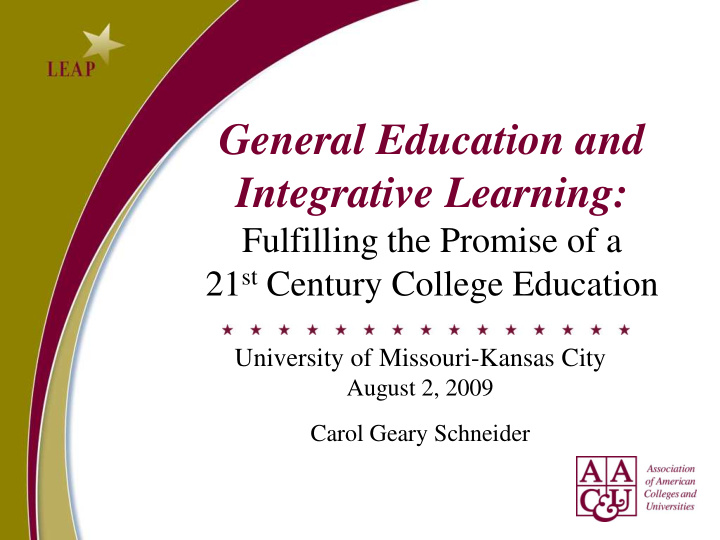



General Education and Integrative Learning: Fulfilling the Promise of a 21 st Century College Education University of Missouri-Kansas City August 2, 2009 Carol Geary Schneider
Changing Designs for College Learning The Nineteenth Century College A Common Core Curriculum (All learning is “general and liberal education”) The Twentieth Century University Breadth + Depth (Breadth = General Studies; Depth = Majors; “liberal education” becomes synonymous with “general education”)
Changing Designs for College Learning The Twenty-First Century Academy A Curriculum in Transition: Rethinking educational purposes and practices to better prepare students for • global interdependence • innovation in the workplace • diverse democracy
2000-2005 – Greater Expectations – A National Dialogue About Goals for College Learning 2005-2015 – Liberal Education and America’s Promise (LEAP) Campus Action Public Advocacy Useful Evidence
Narrow Learning is Not Enough! The Essential Learning Outcomes Knowledge of Human Cultures and the Physical and Natural World Intellectual and Practical Skills Personal and Social Responsibility Integrative Learning
Employers Strongly Endorse the Essential Learning Outcomes – And They Urge New Effort to Help All Students Achieve Them
But Many Students Do Not Understand the Expected Learning Outcomes How many of your students understand your institution’s intended goals or outcomes for undergraduate learning?* Almost all Not many Majority Some * Among members at institutions with learning outcomes for all undergraduates
High Impact Practices: What They Are, Who Has Access to Them, and Why They Matter by George D. Kuh (LEAP report, October 2008, www.aacu.org)
High Impact Practices First-Year Seminars and Experiences Common Intellectual Experiences Learning Communities Writing-Intensive Courses Collaborative Assignments and Projects “Science as Science Is Done”/Undergraduate Research Diversity/Global Learning Service Learning, Community-Based Learning Internships Capstone Courses and Projects
Impact of Educationally Purposeful Practices on First Academic Year GPA by Pre-College Achievement Level *Source: George Kuh , High Impact Educational Practices: What They Are, Who Has Access to Them, and Why They Matter (AAC&U, 2008)
Impact of Educationally Purposeful Practices on First Academic Year GPA by Race/Ethnicity *Source: George Kuh , High Impact Educational Practices: What They Are, Who Has Access to Them, and Why They Matter (AAC&U, 2008)
Impact of Educationally Purposeful Practices on the Probability of Returning for the Second Year of College by Race *Source: George Kuh , High Impact Educational Practices: What They Are, Who Has Access to Them, and Why They Matter (AAC&U, 2008)
Outcomes of High Impact Practices for Underserved Students: A Review of the Literature Lynn Swaner and Jayne Brownell (Forthcoming AAC&U report, 2009)
The Good News High Impact Practices Foster Gains on Essential Learning Outcomes Source: Swaner & Brownell, Outcomes of High Impact Practices for Underserved Students: A Review of the Literature (forthcoming, AAC&U, 2009)
The Sobering News We Have Almost No HIP/Learning Outcomes Research At All on Underserved Students Source: Swaner & Brownell, Outcomes of High Impact Practices for Underserved Students: A Review of the Literature (forthcoming, AAC&U, 2009)
Fulfilling the Promise of Intentional and Integrative Learning
Aims/Outcomes Addressed Across the Curriculum First to Final Year General Education AND the Departments Co-Curriculum as Well
Align Learning Outcomes With Intentional Curricular and Pedagogical Strategies
Broad Knowledge/ Big Questions Introduced in First Year Courses and Experiences Addressed in Advanced, Problem- Based Courses And/or Learning Communities
Intellectual and Practical Skills Incorporated in All General Education Courses Transparently Taken to a Higher Level in the Major and Capstone Work Incorporated in Undergraduate Research and/or Creative Projects
Personal and Social Responsibility Consider a “Mini - Core:” Thematic, Topical Courses First to Final Year
Integrative and Applied Learning Topically Linked Courses Community-Based Learning Milestone and Capstone Projects and Assessments
The Majority of Institutions Use a Distribution Model with Additional Integrative Features 64% 18% 15% Distribution model Distribution model One or more other only with other features features only 23
What are the “Additional Integrative Features?” Common Intellectual Experiences Thematic Required Courses Upper-Level Requirements Core Curriculum – 2 to 4 courses Learning Communities
“ We can — and should — provide every student with an integrative, liberal education — not just some of them. ”
Recommend
More recommend